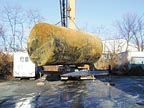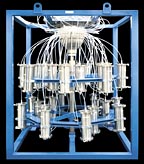
The two “hottest” contaminants today are fuel additives that have found their way into ground water supplies all across the country - perchlorate and methyl tertiary butyl ether (MTBE). Rocket Science: The most recent chemical on the EPA's radar screen as a possible health risk in drinking water is perchlorate. Most of the perchlorate manufactured in the United States, about 90 percent, is used as the primary ingredient of solid rocket propellant - rocket fuel for military missiles and the NASA space shuttle. The rest is used in fireworks, safety flares, matches and car air bags. Waste from the manufacture and improper disposal of perchlorate-containing chemicals increasingly are being found in soil and ground water. It is very water-soluble and does not biodegrade easily.
Perchlorate is both a naturally occurring and a man-made chemical. Some studies suggest that it can interfere with the iodide uptake into the thyroid gland. Iodide is an essential part of thyroid hormones. In adults, the thyroid helps to regulate metabolism; in children, it plays a key role in proper development. However, there are some studies that suggest that perchlorate is not harmful to humans. “There is a debate on the health effects of perchlorate because there are as many studies saying it is not harmful as there are studies saying it is harmful, especially for adults,” notes Tom Palkon, director of product certification at the Water Quality Association. “The new studies are saying it really can cause a problem for infants or fetuses. Yet perchlorate actually is used in medications. That's why some people say it can't be bad for you.”
The EPA has issued a drinking water equivalent level of 1 part per billion (ppb). However, it has not regulated the chemical under the Safe Drinking Water Act as of yet.
Perchlorate has contaminated drinking water supplies, ground water and soil in at least 43 states, notes Environmental Working Group (EWG), a nonprofit environmental research group. About 20 states have perchlorate-contaminated drinking water sources. “Although the majority of known and suspected perchlorate-contaminated sites are operated by the military or its contractors, the U.S. Department of Defense (DOD) and the aerospace and defense industry are stubbornly resisting the efforts of regulators to set adequate safety standards or clean up contaminated sites,” EWG states. “The Defense Department and St. Louis-based Lockheed Martin, which is being sued by 800 residents of San Bernardino, Calif., for cancer and other illnesses they believe were caused by decades of drinking perchlorate-contaminated water, maintain that perchlorate is safe at levels 200 times higher than the EPA's current recommendation.”
In fact, adds EWG, there is strong evidence that the EPA's recommended level of 1 ppb is too high. Last year, defense contractors Kerr-McGee and Lockheed Martin successfully sued California health authorities to reconsider the state's provisional drinking water standard, which forced the state to miss a January 2004 deadline, mandated by state law, for setting an enforceable standard on perchlorate. California's Office of Environmental Health Hazard Assessment has set a public health goal of 6 ppb for perchlorate, but the state's Department of Health Services has yet to set a maximum contaminant level (MCL) for the chemical. And, in a hearing before the House Energy and Commerce subcommittees on the environment and toxic substances, the Defense Department sought exemptions from the Clean Air Act of 1990 and from hazardous waste laws at thousands of firing and bombing ranges nationwide, the Pasadena Star News reported. At stake, the government argues, is its ability to train soldiers for war.
A coalition of public water agencies called the Defense proposal “too broad.” They are worried that, should the DOD receive its exemptions, state and federal authorities would be helpless to prevent more perchlorate contamination in the nation's ground water.

Clean Air, Dirty Water
Methyl tertiary butyl ether (MTBE) is known as a fuel oxygenate, an additive to gasoline in order to increase its oxygen content and help improve air quality. Gasoline containing MTBE is known as reformulated gasoline, which was called for in the Clean Air Act in the form of the Federal Reformulated Gasoline Program. This program was to provide reductions in the emissions of certain air pollutants from automobiles in areas of the country with certain air quality problems, such as major metropolitan areas.MTBE is found in more than 85 percent of reformulated gasoline. Like perchlorate, it is very water-soluble and extremely slow to biodegrade. The EPA-commissioned Blue Ribbon Panel Report stated that 5 percent to 10 percent of drinking water supplies in areas using reformulated gas show at least detectable amounts of the chemical. The U. S. Geological Survey tested wells in 42 states over a five-year period and found the additive in 22 states.
The primary source for MTBE ground water contamination seems to be from leaking underground storage tanks, including the piping, pumps, filling and related components. The National Ground Water Association states that, while many systems have been upgraded, an estimated 15 percent have not. There also are reports of MTBE leaks in upgraded systems, possibly due to inadequate design, installation, maintenance and operation.
“The problem with MTBE is no one knows what levels in the water should be a heath concern,” Palkon says. Research shows that MTBE at low concentrations can affect the taste and odor of water, but the health effects from ingesting or inhaling the gas additive are controversial and still under study. The EPA found that MTBE has a potential for carcinogenicity in rodents, but it has not yet established drinking water standards for it. However, the EPA has listed the additive to its Contaminate Candidate List, and has issued a Drinking Water Advisory stating that “concentrations of MTBE in the range of 20 to 40 parts per billion” should not affect water taste or odor. If MTBE is present, drinking water may taste or smell like turpentine.
Not surprisingly, California has regulated MTBE in the state's drinking water. The California Department of Health Services listed MTBE as a regulated drinking water contaminant with a primary MCL of 13 ppb to address health concerns, enforceable under the California Safe Drinking Water Act and the federal Safe Drinking Water Act. A secondary MCL was established at 5 ppb to address concerns of water taste and odor.
There are several bills pending in Congress that deal with MTBE, says the NGWA. They include banning or phasing out the use of MTBE by state or federal authorities, repealing the Clean Air Act's oxygenate requirement, or requiring changes to current fuel storage tank requirements.

Contaminant Removal
Because MTBE and perchlorate are water-soluble, they are not easy to remove from water. But there are a few existing technologies to remove these fuel additive contaminants from drinking water. Public water systems are using air stripping, granular activated carbon and advanced oxidation to remove MTBE. Home water treatment manufacturers with carbon-filter equipment already have been certified for MTBE removal. Manufacturers can be certified by three entities - the Water Quality Association, NSF Inter-national and Underwriters Laboratories. Reverse osmosis, anion exchange and biological treatment are being tested to remove perchlorate from water.
“WQA soon will have a standard for perchlorate that we could certify products to,” Palkon says. “Manufacturers already are making products or medias that will remove perchlorate from water; they're just waiting for the standards to catch up so they can certify their products.”
ND


Report Abusive Comment